danbricklin.com/log
|
||
|
|
Starting January 12, 2004
Paying for style, Five years of Bricklin.com, Changes: Artists find new revenue and Kodak drops more out of film, Step by step email guidelines, Massachusetts Software Council Annual Meeting: 2004 Outlook, Massachusetts policy on Open Standards
12-29Jan04
2004_01_12.htm
|
|
|
Paying for style [link]
I've added a new essay to the Writings section of my website. It follows on to other essays about what people pay for. I believe that a significant portion of the population has an artistic drive and expresses that drive through their choices of clothes, accessories (worn, carried, used), ornaments (desk, room, cubicle, etc.), tools, and more. Like amateur artists, they pay extra to express themselves. The percentage of one's "disposable" wealth that is knowingly and purposefully spent on style is a factor of who you are and not on how much you have. This drive is responsible for a significant amount of spending that is important to the individuals involved.
Read "Paying for style".
Five years of Bricklin.com [link]
Today is the fifth anniversary of updates to www.bricklin.com. I posted the first "real" update on January 22, 1999, according to my records. The site started taking shape on January 11th, but I like to use today as the anniversary. At the top it said: "This web site is brand new! Come back in a week or two to see how it's changed. [22Jan99]". Five years of somewhat frequent updates, hundreds of pages and thousands of pictures. A long time. It started as just essays in my Writings section, and then moved to include this weblog on October 27, 1999.
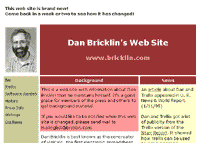 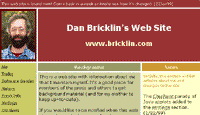 Web site on 1/11/99 and then on 1/22/99
Changes: Artists find new revenue and Kodak drops more out of film [link]
A couple of things I saw in the papers the morning:
The NYTimes Circuits section had an article about music groups selling concert recordings online, usually in an unrestricted MP3 format. It's interesting to watch how artists are finding ways to get paid. (I assume you've read my "How will the artists get paid?" essay.) The revenues are clearly from real fans who don't mind paying, and the record companies do not seem to be involved -- changing that business model. So, instead of showing an artist how much you like them by buying a CD at the concert (for which the artist probably paid wholesale), you buy a copy of the concert itself -- a better memento and more direct money in the artist's pocket. By the way, last weekend I heard the folk singer Odetta perform at the tiny Passim coffee house in Cambridge, Massachusetts, and did buy the CD her accompanist was selling featuring them both. I've got to rip it soon and get it into my PC and iPod...
The other article was in the Wall Street Journal. In a long piece about Kodak, there was this: "As part of its retreat from its traditional business, Kodak also announced last week that it was abandoning its Advanced Photo System camera business and stopping sales this year of reloadable film cameras in the U.S., Canada and Europe..." (Kodak's announcement was buried in a press release that tried to give a pro-film spin to what was happening.) Big changes. Kodak digital camera sales are going up, with good US market share; worldwide film sales are down 8% in 2003 (similar in size to the drop in CD sales in 2002 reported by the RIAA).
Step by step email guidelines [link]
Interland, the company where I'm CTO, has a new web site called SBsuccess.com aimed at helping small businesses take best advantage of their Internet presence. I helped shape one of the articles, so I thought I'd mention it.
It occurred to me, looking at the many articles about the CAN-SPAM act, that most were either discussing it from the viewpoint of the receiver of email (how well the act will or will not work), were aimed at users of a particular bulk mail service, or were short legalese descriptions of the law. Knowing the customers Interland targets with their hand-holding Platinum service (that I've written up here), I felt a more step-by-step, lay person's explanation of what you should do as a normal small business sending out email was needed. That article is now on SBsuccess.com as "What you need to know about the CAN-SPAM Act of 2003". If they missed any good hints for small businesses, let them know. They really do want to be helpful to their readers.
Massachusetts Software Council Annual Meeting: 2004 Outlook [link]
This year's Massachusetts Software Council Annual Meeting and Networking Event was Tuesday night, January 13th, at Boston's Museum of Science. The Software Council has lots of meetings. This is the "annual meeting" where in addition to having speakers and time to meet with others (that other kind of networking), we do formal business such as elect (or reelect) trustees. This time we elected new trustees Lynda Applegate of Harvard Business School, Eileen Rudden of Avaya, Shirley Singleton of Edgewater Technology, and Jeff Taylor of Monster.
 The view out the window up the Charles River of Boston's Back Bay
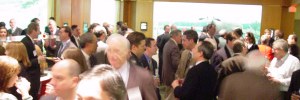  Networking and eating a light dinner, part of an animal exhibit
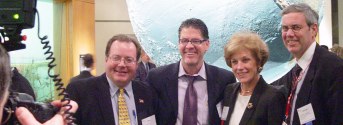 Posing for pictures: Paul Deninger of Broadview and the MATCH School, Jeff Taylor of Monster, Cathy Minehan of the Federal Reserve Bank of Boston, and Michael Kolowich now of DigiNovations
The torch was passed from outgoing Council chair Deb Besemer of Brassring to incoming chair Paul Egerman of eScription.
 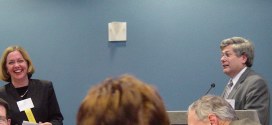 Our new chair, Paul Egerman; Deb Besemer laughs at his joke
The member spotlight highlighted four local educational institutions that emphasize technology: Tech Boston Academy (a new Boston Public School that integrates technology with college prep and includes the inexpensive TechBoston Consulting Group), the MATCH School (Media and Technology Charter High School), the New England region of the National Foundation for Teaching Entrepreneurship (which teaches entrepreneurship to low-income young people), and the Youth Tech Entrepreneurs (offers products and services that enable high schools to develop programs where students use their technology skills to serve their communities).
The main event was a 2004 Outlook Panel. Actually, it was three speakers, one after another, not a panel, but it was interesting nonetheless. What follows is what I remember from those talks (I didn't take careful notes, just pictures of their slides):
The first speaker was Cathy Minehan, President and CEO of the Federal Reserve Bank of Boston.
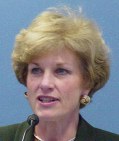 Cathy Minehan
Here are the titles of some of her slides which tell much of her story, leaving out lots of facts and details:
Consumer spending continued strong through 2003:H2. Led by strong auto sales. Residential investment continues its surge. The long-awaited recovery in capital spending appears to have begun in earnest. And recent indicators suggest that this momentum will continue in 2004. Significant earnings growth will also give capital spending a lift in 2004. In contrast to 2001/2002, bond markets will support consumer and business spending in 2004. As will equity markets. Stimulative monetary policy has helped... as has a combination of federal tax cuts... and defense-related spending. But consensus forecasts expect a self-sustaining, privately-driven recovery in 2004. A remaining issue: Employment growth. Forward looking indicators suggest labor markets are now in more stable territory. Productivity growth has been very strong. Which is one reason why inflation has been trending down, and should remain benign. We don't expect much help from abroad... except from the recent declines in the value of the dollar... which have likely helped manufacturing.
Summary: Self-sustaining private recovery in train. Capital spending is recovering - relatively good news for the tech sector. Consumer spending, housing continue support. Employment growth still meager; we need more.
A side note on the dangers of "helpful" computer systems. The three speakers shared a single laptop for their PowerPoint presentations. During Cathy's talk the following pop-ups came up over PowerPoint (while she was looking at us and not the screen, of course, causing us all to get very distracted and uncomfortable...):
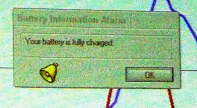 Unwelcome message during PowerPoint: Battery charging done
 Another: Wireless signal available (others in the room couldn't connect to it)
The next speaker was Gary Beach, Group Publisher, CXO Media. He talked about data that CIO magazine has collected using surveys. He's very entertaining, and was especially so, since he had his son in the audience to hear what Daddy does.
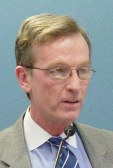 Gary Beach
He started by showing a slide that showed that the drop in IT spending occurred before September 11, 2001, mainly in the first half of 2001 with a very dramatic drop, and has stayed low since:
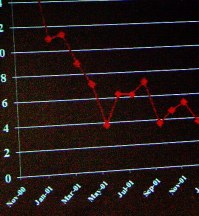 Drop in IT spending starting January 2001
From 2001 to June of 2003, he says the driver of (the low) IT spending has been: Weak profits, tight financial controls, less competition, and sufficient capacity ("The Law of More"). The turn occurred in May 2003. The drivers of IT spending (now going up) from June 2003 to the present are: Improving economy, aging infrastructure, significant application backlog (not just saying you have a backlog -- calling it "significant" matters), and competitive pressure. He says we have started moving, but are only in "low second gear" so far. Important drivers of spending are also "CCS": Compliance (SEC-type, HIPAA, etc.), Collaboration (connecting Intranets to the Extranet), and Security. The most important driver will be the employment rate.
Gary pointed to the "How Much Information?" study at Berkeley. It found that "Print, film, magnetic, and optical storage media produced about 5 exabytes of new information in 2002. Ninety-two percent of the new information was stored on magnetic media, mostly in hard disks... Information flows through electronic channels -- telephone, radio, TV, and the Internet -- contained almost 18 exabytes of new information in 2002, three and a half times more than is recorded in storage media. Ninety eight percent of this total is the information sent and received in telephone calls - including both voice and data on both fixed lines and wireless." That's a lot of data. That's without RFID. We'll need to do something with all this data. That's opportunity.
The final speaker was John Landry, now of Adesso Systems, formerly of IBM, Lotus, McCormack & Dodge, etc. He talked about technical trends.
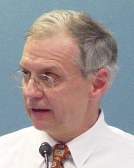 John Landry
John packs lots of information and details into his slides to back up the major ideas he puts forth. He was going to start with a PowerPoint animation and a rap song he'd recorded, but the transfer of the files to this shared machine lost the embedded multimedia. Sigh. More problems even us techies run into with "normal people" tools that look so good in the demos.
His first main important technical area was processor speed. 64-bit CPUs from Apple and AMD (but need to wait for OS that exploits them) and Intel 3+ GHz processors, etc. All fast enough to easily do HDTV encoding.
New buses and motherboard layouts are coming. PCI Express will speed internal to the computer, and USB 2.0/Gigabit Ethernet will move stuff outside. New motherboard layouts will cut down the number of fans needed and add to modularity.
"2004 - The year of LCD's". Size, more vivid color, etc. Higher refresh rates needed for video.
"Cheap Storage Gets Even Cheaper." Faster with Serial ATA. Network attached storage. Smaller, like SD cards.
Wireless LANs. PANs with Bluetooth and eventually Ultra Wide Band. WANs - 3G. WiMax MAN: 802.16a WiderFi - WiFi speeds to 30 miles.
IDEs and Machine-to-Machine standards. .NET vs. J2EE.
The mobilization of everything. Digitainment: The multiplex at your crib. VoIP and VoWLAN. Mobile interactive displays. TiVo bridging to PC. Smart personal objects technology, like Microsoft's watch. RFID.
A problem he brought up: Most of what he talked about was consumer driven. In the enterprise, what new area is there to open up? We've done payroll, accounts payable, MRP, CRM, etc. What's next? Some very hard stuff in core business processes.
Occasionally connected architectures. We had LANs, Web, and now Wireless. The difference? Occasional connectivity as opposed to always connected. (The PC at first was totally unconnected, except to it's peripherals that were always connected.) Need new models of design.
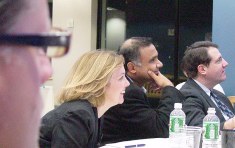 Jeff Taylor, Deb Besemer, Shikhar Ghosh, Steve DiPietro (of meeting sponsor Deloitte & Touche) listen to John
John's last slide:
Enormous Exciting Changes Ahead:
That's it!
Massachusetts policy on Open Standards [link]
This afternoon the Commonwealth of Massachusetts released three documents setting out its policy on "open standards". This is the result of discussions that have been going on for months, which included hearings attended by computer industry people, as I reported last October 8th. There has been much angst in the software community about the discussions about "open source", with people worrying that there will be a mandate for "Linux Desktop/Open Office" throughout the state. Secretary Kriss had told me that the concern was more the other way: Open source applications such as Apache were so underrepresented in use by the state compared to in commercial situations that the playing field needed some leveling.
The guidelines say:
"For all prospective IT investments, agencies must consider as part of the best value evaluation all possible solutions, including open standards compliant open source and proprietary software as well as open standards compliant public sector code sharing at the local, state and federal levels."
There are three documents listed on their IT Division page:
Notice how "Open Source" refers mostly to the "free as in freedom" part of open source (with the word "is") and does not require the "free as in free beer" part some open source is associated with (using the word "may"). After discussions with the state IT people, I can tell you that they are well aware of the nuances between the different licensing terms such as for Apache/Artistic, GPL, etc. Also, notice the discussion about sharing among public entities.
Read them to see what really has been decided.
|
||
|
© Copyright 1999-2018 by Daniel Bricklin
All Rights Reserved.
See disclaimer on home page.
|
||